Engineering:Chengdu J-10
| J-10 Vigorous Dragon | |
|---|---|

| |
| A J-10B carrying PL-8 and PL-12 air-to-air missiles | |
| Role | Multirole combat aircraft |
| National origin | China |
| Manufacturer | Chengdu Aircraft Industry Group |
| Design group | Chengdu Aircraft Design Institute |
| First flight | 23 March 1998[1] |
| Introduction | 2005[2] |
| Status | In service |
| Primary users | People's Liberation Army Air Force People's Liberation Army Naval Air Force Pakistan Air Force |
| Produced | 2002 – present[3] |
| Number built | 602+ as of 2022[4] |
The Chengdu J-10 Vigorous Dragon (Chinese: 歼-10 猛龙; pinyin: Jiān-10 Měnglóng; NATO reporting name: Firebird[5][6]), is a medium-weight, single-engine, multirole combat aircraft capable of all-weather operations, configured with a delta wing and canard design,[7] with fly-by-wire flight controls, and produced by the Chengdu Aircraft Corporation (CAC) for the People's Liberation Army Air Force (PLAAF), Pakistan Air Force (PAF) and People's Liberation Army Naval Air Force (PLANAF). The J-10 is mainly designed for air-to-air combat, but can also perform strike missions.
Development

In 1981, PLAAF Commander Zhang Tingfa submitted a proposal to Deng Xiaoping for the development of a third-generation fighter for CN¥ 500,000,000; it was accepted later that year by the Central Military Commission (CMC). It was the first Chinese aircraft program to incorporate modern development and acquisition processes.[8] In one departure from the past, the supplier was now responsible directly to the customer; this allowed the PLAAF to communicate its requirements and ensure they were met; previously suppliers were responsible to their managing agency, which could produce products that failed to meet end user requirements.[8] Another difference was the selection of a design through competition, rather than allocating a project to an institute and using whatever design that institute created.[9]
Design proposals were made by the three major aircraft design institutes. Shenyang's proposal was based on its cancelled J-13 with a F-16-like strake-wing. Hongdu's proposal was MiG-23/Su-24-like with variable-sweep wing. Chengdu Aircraft Design Institute's (CADI) proposal was a Saab 37 Viggen-like design based on its cancelled J-9.[9] CADI's proposal was selected in February 1984. The following month, CADI and Chengdu Fighter Factory were formally directed to develop and manufacture the aircraft, respectively.[10] Song Wencong (宋文骢) became chief designer.[11]
The engine was selected during the design proposal stage.[8] Candidates were an improved Woshan WS-6, the WP-15, or a new engine. The new engine, ultimately the Shenyang WS-10, was chosen in 1983.[12]
The State Council and the CMC approved the program in 1986,[10][8] code-naming it "No. 10 Project".[10] Interest waned in the following years which constrained funding and prolonged development. The Gulf War renewed interest and brought adequate resourcing.[13] Unlike earlier programs, the J-10 avoided crippling requirement creep.[13]
Technical development was slow and difficult. The J-10 represented a higher level of complexity than earlier generations of Chinese aircraft. About 60% of the aircraft required new technology and parts, instead of - according to Chengdu - the usual 30% for new aircraft; the high proportion reflected both requirements and limited domestic capability.[11] Development and modernization of China's aviation industry occurred alongside the J-10;[11][13] the program was an early Chinese user of digital design, modelling, and testing[14] including computer-aided design (CAD) and computational fluid dynamics.[11] The J-10 was the first Chinese aircraft to make major use of CAD for its structural design,[11] allowing the detailed design to be completed in 1994.[14][10] The hydraulics system was tested with physical models because of limited digital modelling capabilities.[11]
The first J-10 was assembled in June 1997.[10] Lei Qiang flew the first flight[11] on 23 March 1998;[1] Lei was chosen for his experience with modern, foreign, third-generation aircraft.[11] PLA training units received the J-10 ahead of schedule starting in 2003.[11] Weapons tests occurred in the fall of that year.[15] The design was finalized in 2004.[10] Rumors of crashes during flight testing were actually mishaps related to the AL-31 engine.[16]
The J-10 became operational in 2006.[10] It was officially unveiled by the Chinese government in January 2007, when photographs were published by Xinhua News Agency.[16]
The Siberian Aeronautical Research Institute (SibNIA) from Russia was involved in the program by 2016. According to SibNIA, it was only observing and instructing as "scientific guides".[17]
According to the images posted by China National Radio of a PLAAF live-firing exercise at an unspecified location in May 2021, J-10C Vigorous Dragons were equipped with distinctive exhaust nozzles of the WS-10B Taihang turbofan engine.[18] This marks the first time the WS-10 has been officially seen on an operational J-10.[19]
Disputed origins
In 1988 Israel's defense minister denied a report by The Sunday Times that Israel and China had agreed to develop a fighter derived from the IAI Lavi, a project based on the F-16.[20] In 2006, Russia's SibNIA engineers believed that the J-10 was "more or less a version" of the Lavi, incorporating "a melting pot of foreign technology and acquired design methods... but there are a number of other pieces of other aircraft or technologies that are part of the configuration that they have acquired from different sources."[17] In 2008, Janes claimed that the J-10 benefited from technical information from the Israeli project, citing senior Russian engineers who said they had heard this from Chinese colleagues.[21]
The Chinese assert J-10's features claimed to be from the Lavi are from the manufacturer's own previous aircraft design, for example attributing the J-10's Lavi-like double canard configuration to Chengdu's work on the cancelled J-9[9] of the 1960s and 1970s;[10] this view is supported by Song Wencong,[22] who worked on the J-9 and became the J-10's chief designer,[11] and PLAAF Major General Zhang Weigang.[23]
Design
The J-10 was designed and developed by the Chengdu Aircraft Design Institute (CADI), a subsidiary of Chengdu Aircraft Corporation.
Airframe
The airframe is constructed from metal alloys and composite materials for high strength and low weight, the airframe's aerodynamic layout adopts a "tail-less canard delta" wing configuration. A large delta wing is mid-mounted towards the rear of the fuselage, while a pair of canards (or foreplanes) are mounted higher up and towards the front of the fuselage, behind and below the cockpit. This configuration provides very high agility, especially at low speeds, and also reduces stall speed, allowing for a lower airspeed during instrument approaches. A large vertical tail is present on top of the fuselage and small ventral fins underneath the fuselage provide further stability.[citation needed]
On J-10A, a rectangular air intake ramp and a splitter plate are located underneath the fuselage, providing the air supply to the engine.[24] Newer variants, including J-10B and J-10C use a diverterless intake that does not require a splitter plate, and may reduce radar cross signature.[24] Under the fuselage and wings are 11 hardpoints, used for carrying various types of weaponry and drop-tanks containing extra fuel. The retractable undercarriage comprises a steerable pair of nose-wheels underneath the air intake and two main gear wheels towards the rear of the fuselage.[citation needed]
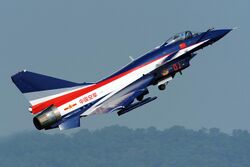
The cockpit is covered by a two-piece bubble canopy providing 360 degrees of visual coverage for the pilot. The canopy lifts upwards to permit cockpit entry and exit. The controls take the form of a conventional centre stick and a throttle stick located to the left of the pilot. These also incorporate "hands on throttle and stick" (HOTAS) controls.[citation needed] A zero-zero ejection seat is provided for the pilot, permitting safe ejection in an emergency even at zero altitude and zero speed.[citation needed]
Due to the J-10's aerodynamically unstable design, a digital quadruplex-redundant fly-by-wire (FBW) flight control system (FCS) aids the pilot in flying the aircraft. The FCS typically monitors pilot control inputs, preventing the pilot from accidentally exiting the flight envelope from applying too much control input during high performance flight situations.[citation needed] This is critical in canard wing aircraft, as they are capable of turning in a much tighter radius than conventional aircraft. The massive control surfaces are capable of moving so far that they can completely destroy the aircraft in flight at high airspeeds if not kept in check by the FCS.[citation needed]
Avionics
The cockpit has three liquid crystal (LCD) Multi-function displays (MFD) along with a Chinese developed holographic head-up display (HUD), all of which are fully compatible with a domestic Chinese advanced helmet mounted sight (HMS), claimed by Chinese to be superior to the HMS on the Sukhoi Su-27 sold to China.[25][26]
Radar
According to Chengdu Aircraft Corporation officials the J-10 uses a multi-mode fire-control radar designed in China. The radar has a mechanically scanned planar array antenna and is capable of tracking 10 targets. Of the 10 targets tracked, 2 can be engaged simultaneously with semi-active radar homing missiles or 4 can be engaged with active radar homing missiles.[27]
For J-10B, the nose cone is modified to accommodate an active phased array airborne radar (AESA) radar.[28][29] The general designer of AESA for J-10B is Mr. Zhang Kunhui (张昆辉, 1963 -), the head of 607 Research Institute in Neijiang, Sichuan. Mr. Zhang Kunhui became the deputy head of 607th Research Institute in 1997, and four years later in 2001, he became the head of the institute, when the AESA program for J-10B started. The primary contractor of this AESA is the Radar and Electronic Equipment Research Academy of Aviation Industry Corporation of China located in Sichuan, formed in March 2004 by combining the 607th Research Institute and 171st Factory together with Mr. Zhang Kunhui was named as the head of the research academy. According to Chinese governmental media, the AESA for J-10B took 8 years to develop, finally completed in 2008, and Chinese fighter radars hence achieved a quantum leap in that it went from mechanically scanned planar slotted array directly into AESA, skipping the passive phased array PESA radar.[30] Many suspected the radar is a PESA, but during its brief debuts in the 7th China International Defense Electronics Exhibition (CIDEX) in May 2010 and the 6th International Conference on Radar held in Beijing in Sept 2011, Chinese official sources have claimed it is an AESA.[31]
Propulsion
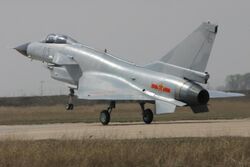
The J-10 is powered by a single turbofan. The J-10A entered production with the Russian Salyut AL-31FN.[24] The initial version generated a maximum static thrust of 12,500 kgf (123 kN; 28,000 lbf).[32] In December 2013, Salyut reported it was testing an upgraded AL-31FN Series 3 for China with 250 hours more life and 1000 kg/f more thrust; the Series 3 would be equipped on the improved J-10B.[33][34] Compared to the original Lyulka-Saturn AL-31F, the AL-31FN was fitted to the J-10 by rotating the gearbox and accessory pack to the underside.[24]
The J-10s intended engine is the Chinese Shenyang WS-10. The WS-10 suffered development difficulties and production of the aircraft went ahead with the Salyut AL-31FN as a substitute.[35] A pre-production J-10C flew with a WS-10 at the 2018 China International Aviation & Aerospace Exhibition; the engine nozzle was modified for stealth and thrust vectoring (TVC).[24] In March 2020, a video from Chinese state media showed a J-10C in PLAAF livery equipped with the WS-10B;[33] WS-10B-powered aircraft were in service by November 2021.[36]
Weaponry and external loads
The aircraft's internal armament consists of a Gryazev-Shipunov GSh-23 twin-barrel cannon, located underneath the port side of the intake. Other weaponry and equipment is mounted externally on 11 hardpoints, to which 5,600 kg (12,300 lb) of either missiles and bombs, drop-tanks containing fuel, or other equipment such as avionics pods can be attached.[citation needed]
Air-to-air missiles deployed may include short-range air-to-air missiles such as the PL-8 and PL-10 (on J-10C), medium-range radar-guided air-to-air missiles such as the PL-12 and PL-15 (on J-10C), unguided and precision guided munitions such as laser-guided bombs, air-to-surface missile such as KD-88,[37] anti-ship missiles such as the YJ-91A,[37] and anti-radiation missiles such as the YJ-91.[37]
Operational history
China
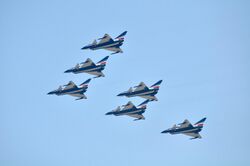
The first aircraft were delivered to the 13th Test Regiment on 23 February 2003. The aircraft was declared 'operational' in December of the same year, after 18 years in development.[1][38]
The J-10C entered combat service in April 2018.[39]
Pakistan
Negotiations for acquisitions for J-10A were started in 2006 when offered by China,[40][41] but negotiations persisted into 2012 with the offer of the J-10B.[42]
In September 2020, it was reported that Pakistan was interested in the J-10C.[43] In December 2021, Pakistan announced the purchase of 25 J-10CEs, with an option for 11 more; they were expected to enter service in March 2022.[44][45] On 4 March 2022, the first batch of 6 J-10CEs for the Pakistan Air Force (PAF) landed at PAF Base Minhas (Kamra) after a ferry flight from Chengdu, China.[46] They were officially inducted into the PAF's No. 15 Squadron Cobras based at PAF Base Minhas on 11 March 2022.[6][47][48]
On 18 January 2024, Pakistan launched a series of air and artillery strikes inside Iran, targeting Baloch separatist groups, multiple JF-17C and Wing Loong II drones escorted by J-10CE launched attacks against BLA and BLF militant groups with GIDS B-REK Glidebombs. 9 People were killed in the attack.[49]
Exports to other countries
In 2009, AVIC planned to offer the J-10 and the CAC/PAC JF-17 Thunder for export. Flightglobal speculated an upgraded J-10B would be offered.[50]
In 2023, Saudi Arabia is in talks with China to potentially buy J-10C fighter jets.[51] Egypt has also expressed interest in purchasing 12 J-10C jets.[52][53]
Variants
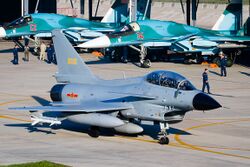
- J-10A: Single seat variant. The export designation is F-10A[54] or FC-20.[55]
- J-10AH: Naval version of J-10A.
- J-10AY: Acrobatics variant of J-10A.[56]
- J-10S: Tandem-seated trainer variant of J-10A.[57]
- J-10SH: Naval version of J-10S.
- J-10B: An upgraded J-10, initially identified as "Super-10".[58] It features a lighter and stealthier diverterless supersonic inlet, a longer nose radome possibly housing an active electronically scanned array radar, an electro-optic targeting sensor (IRST, and laser rangefinder,) and a new electronic warning or countermeasures pod atop the vertical stabiliser.[59] The aircraft is powered by the AL-31FN M1;[59] one unit was flown with a WS-10A in July 2011 but that engine was not selected for the initial production batch.[60] The aircraft's first flight occurred no later than December 2008.[61]
- J-10B TVC Demonstrator: A prototype fighter based on J-10B that is equipped with WS-10B thrust-vectoring control engine. The fighter has supermaneuverability, capable of performing Cobra maneuver.[62]
- J-10C: An upgraded version of J-10B, it is equipped with an indigenous AESA fire-control radar and is equipped with imaging infrared seeker (IIR) PL-10, WS-10B engine[63] and PL-15 air-to-air missiles.[64][65]
- J-10CE: Export version of J-10C.[66]
- J-10CY: Acrobatics variant of J-10C, replaced J-10AY.[56]
- J-10D: Electronic warfare variant with straight, protruding dorsal spine in the central airframe, containing electronic countermeasure and warfare systems.[67]
Operators
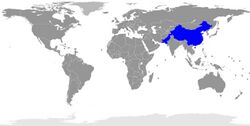
 People's Republic of China
People's Republic of China
- People's Liberation Army Air Force : 220 J-10A, 55 J-10B, 220 J-10C, 70 J-10S as of 2022[4]
- People's Liberation Army Naval Air Force : 16 J-10AH, 7 J-10SH as of 2021[68]
 Pakistan
Pakistan
Accidents and incidents
On 12 November 2016, an August 1st Aerobatics Team training flight suffered a mid-air collision in Hebei. A twin-seat J-10 crashed. The pilot, Captain Yu Xu, and the co-pilot ejected, but Yu was struck by another J-10 and killed. Yu was the first woman certified to fly the J-10.[76]
Specifications (J-10C)


Data from [77]
General characteristics
- Crew: 1[38]
- Length: 16.9 m (55 ft 5 in)
- Wingspan: 9.8 m (32 ft 2 in)
- Height: 5.7 m (18 ft 8 in)
- Wing area: 37 m2 (400 sq ft)
- Empty weight: 9,750 kg (21,495 lb) [78][unreliable source?]
- Gross weight: 14,000 kg (30,865 lb)
- Max takeoff weight: 19,227 kg (42,388 lb) [38][78]
- Fuel capacity: 4950 L (3860 Kg) internal.[78] 4000 L (3120 Kg) external with 3 drop tanks (2x1600L + 1x800L)[79]
- Powerplant: 1 × WS-10B afterburning turbofan engines, 89.17 kN (20,050 lbf) thrust dry, 144[80] kN (32,000 lbf) with afterburner
Performance
- Maximum speed: Mach 1.8
- Stall speed: 200 km/h (120 mph, 110 kn)
- Range: 1,850 km (1,150 mi, 1,000 nmi) [81][78]
- Combat range: 1,240 km (770 mi, 670 nmi) [81][78]
- Ferry range: 4,600 km (2,900 mi, 2,500 nmi)
- Service ceiling: 18,000 m (59,000 ft) [78]
- g limits: +9/-3[78]
- Rate of climb: 300 m/s (59,000 ft/min) [82]
- Wing loading: 381 kg/m2 (78 lb/sq ft)
- Thrust/weight: 1.04
Armament
- Guns: 1× Gryazev-Shipunov GSh-23
- Hardpoints: 11 in total (6× under-wing, 2× under-intake and 3× under-fuselage) with a capacity of 5600 kg of external fuel and ordnance,
- Rockets: 90 mm unguided rocket pods
- Missiles:
- Air-to-air missiles:
PL-8
PL-10 (J-10C)
PL-12
PL-15 (J-10C) - Air-to-surface missiles:
KD-88[37] standoff land attack missile
YJ-91[37] anti-radiation missile
- Air-to-air missiles:
- Bombs:
Laser-guided bombs: (LS-500J,[83] LT-2)
Glide bombs: (LS-6, GB3, GB2A, GB3A)
Satellite-guided bombs: (FT-1)
Unguided bombs: 250 kg, 500 kg
- Others:
- Up to 3 external fuel drop-tanks (1× under-fuselage, 2× under-wing) for extended range and loitering time
Avionics
- Radar
- AESA radar(J-10C)[84]
- Type 1473H pulse-doppler fire-control radar (J-10A)
- Externally mounted avionics pods:
- K/JDC01A targeting pod (on J-10A)[85]
- Type Hongguang-I infra-red search and track pod (on J-10A)
- CM-802AKG targeting pod for KD-88 and YJ-91 (on J-10C)[85]
- KG600 electronic countermeasure pod[85]
- Blue Sky navigation/attack pod
See also
Related development
Aircraft of comparable role, configuration and era
- CAC/PAC JF-17 Thunder
- Dassault Rafale
- Eurofighter Typhoon
- General Dynamics F-16 Fighting Falcon
- Mikoyan MiG-35
- Mitsubishi F-2
References
Citations
- ↑ 1.0 1.1 1.2 Wang Jieqing. "J-10 Fighter Test Flight Process Secret Revealed". Southern Weekend. http://jczs.news.sina.com.cn/p/2007-01-04/1154424536.html.
- ↑ "Japan's F-2 vs. China's Lethal J-10 Fighter: Who Wins?". 13 October 2015. https://nationalinterest.org/feature/japans-f-2-vs-chinas-j-10-who-wins-14056.
- ↑ "Chengdu J-10 (Jian-10, Fighter aircraft-10 / F-10)". globalsecurity.org. http://www.globalsecurity.org/military/world/china/j-10.htm.
- ↑ 4.0 4.1 For Strategic Studies (Iiss), The International Institute (15 February 2023). "6 Asia". The Military Balance 2023. London: Routledge. doi:10.4324/9781003400226. ISBN 9781003400226.
- ↑ 6.0 6.1 Jennings, Gareth (11 March 2022). "Pakistan receives first J-10 fighters from China". https://www.janes.com/defence-news/news-detail/pakistan-receives-first-j-10-fighters-from-china.
- ↑ "Delta Wing". http://aviationearth.com/Theory/deltawing.html.
- ↑ 8.0 8.1 8.2 8.3 Research, Development, and Acquisition, page 2
- ↑ 9.0 9.1 9.2 Research, Development, and Acquisition, page 3
- ↑ 10.0 10.1 10.2 10.3 10.4 10.5 10.6 10.7 Lumbering Forward, page 61
- ↑ 11.00 11.01 11.02 11.03 11.04 11.05 11.06 11.07 11.08 11.09 Lumbering Forward, page 62
- ↑ China’s Aeroengine Industry, page 26
- ↑ 13.0 13.1 13.2 Research, Development, and Acquisition, page 4
- ↑ 14.0 14.1 Lumbering Forward, page 41
- ↑ Lumbering Forward, page 63
- ↑ 16.0 16.1 Rupprecht, Andreas, 2013. Dragon's Wings. Birmingham: Ian Allan Publishing Ltd.
- ↑ 17.0 17.1 "SibNIA remains center of Russian innovation". 2007. https://www.ainonline.com/aviation-news/2006-11-15/sibnia-remains-center-russian-innovation.
- ↑ Waldron, Greg (21 May 2021). "China's J-10 comes of age with indigenous engine". https://www.flightglobal.com/defence/chinas-j-10-comes-of-age-with-indigenous-engine/143852.article.
- ↑ Yeo, Mike (2021-05-11). "China fields J-10 jets powered by homemade engine" (in en-US). https://www.defensenews.com/global/asia-pacific/2021/05/11/china-fields-j-10-jets-powered-by-homemade-engine/.
- ↑ "Pakistan Purchases Chinese Jets Based on Scrapped Israeli Lavi Fighter". Haaretz. https://www.haaretz.com/world-news/asia-and-australia/pakistan-purchases-chinese-jets-based-on-scrapped-israeli-lavi-fighter-1.10510613.
- ↑ Hewson, Robert. "Chinese J-10 'benefited from the Lavi project'". Jane's, 19 May 2008.
- ↑ "Exclusive Interview with J-10 General Designer Song Wencong". 2007. http://military.china.com/zh_cn/news/568/20070105/13858504.html.
- ↑ "少将驳斥"战机抄袭论":歼-10源自于歼-9". 2012. http://www.hrjs.net/article/zhongguo/2012/0309/681.html.
- ↑ 24.0 24.1 24.2 24.3 24.4 Johnson, Reuben F. (22 November 2019). "Dubai Airshow 2019: China's Chengdu promotes J-10C export variant". https://www.janes.com/defence-news/news-detail/dubai-airshow-2019-chinas-chengdu-promotes-j-10c-export-variant.
- ↑ "中国第四代先进战机机头及座舱亮相珠海航展(图)-吊舱,头盔瞄准具,航电系统,凤凰网,凤凰新媒体-黄岩新闻网". http://hynews.zjol.com.cn/hynews/system/2010/11/13/012886930_02.shtml.
- ↑ sina UI Team. "这个是歼10战机飞行员头盔瞄准具吗?". http://club.mil.news.sina.com.cn/viewthread.php?tid=7300&page=1.
- ↑ "Jian-10 (J-10, F-10) Multirole Fighter Aircraft". SinoDefence.com. http://www.sinodefence.com/airforce/fighter/j10.asp.
- ↑ "歼10B有源相控阵雷达曝光 配置与美军一致(组图)". http://www.sinonet.org/news/military/2011-12-27/178695.html.
- ↑ "网曝中国空军歼10B机载雷达照 与美战机类似引热议". http://www.liangjian.com/news/201112/6344_5.html.
- ↑ "创新超越促发展--记中航工业雷电院长张昆辉" cannews.com.cn 14 January 2013
- ↑ "中国歼-10B相控阵雷达首次曝光:达世界先进水平 - 复兴网". http://www.fxingw.com/wwjx/2012-05-14/22032.html.
- ↑ "AL-31FN" (in ru). Salyut. http://www.salut.ru/ViewTopic.php?Id=654.
- ↑ 33.0 33.1 Ju, Juan (5 March 2020). "Images suggest China has begun fitting indigenous WS10 engine into J-10C fighters". https://www.janes.com/defence-news/news-detail/images-suggest-china-has-begun-fitting-indigenous-ws10-engine-into-j-10c-fighters.
- ↑ "FSUE "Gas-Turbine Engineering RPC "Salut" has successfully completed the first phase of engine longevity and performance bench tests in view of future deliveries of a new version of AL-31FN Series 3.". 24 December 2013. http://www.salut.ru/ViewTopic.php?Id=2189.
- ↑ Wood, Peter; Stewart, Robert (26 September 2019). China's Aviation Industry: Lumbering Forward. United States Air Force Air University China Aerospace Studies Institute. p. 32. ISBN 978-1082740404. https://www.airuniversity.af.edu/Portals/10/CASI/Books/Lumbering_Forward_Aviation_Industry_Web_2019-08-02.pdf?ver=2019-08-05-102041-830. Retrieved 20 September 2020.
- ↑ Giovanzanti, Alessandra (23 November 2021). "PLAAF 25th Air Brigade now operates J-10C multirole fighters". https://www.janes.com/defence-news/news-detail/plaaf-25th-air-brigade-now-operates-j-10c-multirole-fighters.
- ↑ 37.0 37.1 37.2 37.3 37.4 Rupprecht, Andreas (2018). Modern Chinese Warplane: Chinese Air Force - Aircraft and Units. Harpia Publishing. p. 118. ISBN 978-09973092-5-6.
- ↑ 38.0 38.1 38.2 "Sinodefence.com: J-10 Multirole Fighter Aircraft". http://www.sinodefence.com/airforce/fighter/j10.asp.
- ↑ ZX, ed (16 April 2018). "China's fighter jet J-10C begins combat duty". Xinhuanet. http://www.xinhuanet.com/english/2018-04/16/c_137115186.htm.
- ↑ "Pakistan will stand by China against US 'siege', says Rashid". Daily Times (Pakistan). 23 February 2006. http://www.dailytimes.com.pk/default.asp?page=2006/02/23/story_23-2-2006_pg7_50.
- ↑ Ansari, Usman (3 August 2011). "China Officially Offers Pakistan J-10 Variant". Defense News. http://www.defensenews.com/article/20110803/DEFSECT01/108030311/China-Officially-Offers-Pakistan-J-10-Variant.
- ↑ "J-10B fighter planes, 6 marines for Pakistan as Cino-Pak talks underway and lead to pakistan acquiring 100 j-10 and f16 super hornets". The News Tribe. 22 March 2012. http://www.thenewstribe.com/2012/03/22/j-10-fighter-planes-6-marines-for-pakistan-as-cino-pak-talks-underway/.
- ↑ Chowdhury, Srinjoy (6 September 2020). "Pakistan reaches out to China for more fighter jets and missiles". https://www.timesnownews.com/international/article/pakistan-reaches-out-to-china-for-more-fighters-and-missiles/648512.
- ↑ 44.0 44.1 Kumar, Ankit (29 December 2021). "Pakistan confirms raising squadron of Chinese J-10C in response to India's Rafale jets". https://www.indiatoday.in/world/story/pakistan-confirms-raising-squadron-of-chinese-j-10c-in-response-to-india-s-rafale-jets-1893852-2021-12-29.
- ↑ 45.0 45.1 "Pakistan acquires squadron of elite J-10C fighter: reports". 30 December 2021. https://www.pakistantoday.com.pk/2021/12/30/pakistan-acquires-squadron-of-elite-j-10c-fighter-reports/.
- ↑ 46.0 46.1 "Pakistan receives first batch of China's J-10CE fighter jets - SAMAA". Samaaenglish.tv. https://www.samaaenglish.tv/news/2022/03/pakistan-receives-first-batch-of-chinas-j-10-fighter-jets/. Retrieved 2022-03-14.[yes|permanent dead link|dead link}}]
- ↑ "Multi-role J-10C fighter jets inducted into PAF fleet". 11 March 2022. https://tribune.com.pk/story/2347447/multi-role-j-10c-fighter-jets-inducted-into-paf-fleet.
- ↑ "Six China-made J-10C jets inducted into PAF". 12 March 2022. https://www.dawn.com/news/1679529.
- ↑ https://www.wionews.com/south-asia/explained-which-weapons-were-used-how-exactly-did-pakistan-carry-out-airstrikes-in-iran-681328
- ↑ Siva Govindasamy, "China's AVIC steps up sales push for FC-1, J-10 fighters" , Flight International, Retrieved: 2 October 2009
- ↑ "China said to be negotiating arms deals with Saudi Arabia and Egypt" (in en). 2023-05-24. https://www.scmp.com/news/china/military/article/3221715/china-said-be-negotiating-arms-deals-saudi-arabia-and-egypt.
- ↑ "Military Watch Magazine". https://militarywatchmagazine.com/article/saudi-china-j10c-drone-classes.
- ↑ Honrada, Gabriel (2023-05-26). "China seizing US arms markets in the Middle East" (in en-US). https://asiatimes.com/2023/05/china-seizing-us-arms-markets-in-the-middle-east/.
- ↑ "Pakistan approves purchase of Lockheed Martin F-16s and Chengdu J-10 fighters-13 April 2006-Washington DC-Flight International". Flightglobal.com. 13 April 2006. http://www.flightglobal.com/articles/2006/04/13/205968/pakistan-approves-purchase-of-lockheed-martin-f-16s-and-chengdu-j-10.html.
- ↑ Lei, Zhao (18 February 2016). "PLA's fighter jets go up for sale". China Daily. http://www.chinadaily.com.cn/china/2016-02/18/content_23529890.htm.
- ↑ 56.0 56.1 Parken, Oliver (29 March 2023). "The J-10 Changed China’s Fighter Game 25 Years Ago". https://www.thedrive.com/the-war-zone/the-j-10-changed-chinas-fighter-game-25-years-ago.
- ↑ Kopp, Carlo (10 July 2007). "J-10S Dual Seat Variant". Air Power Australia. pp. 1. http://www.ausairpower.net/APA-Sinocanard.html#mozTocId283408.
- ↑ Ivanov, Henry (9 January 2006), China working on "Super-10" advanced fighter, Janes Defence World, http://www.janes.com/defence/air_forces/news/jdw/jdw060109_2_n.shtml
- ↑ 59.0 59.1 Weening, Alexander; Hardy, James (9 October 2014). "New pictures of J-10B revealed". IHS Jane's 360. http://www.janes.com/article/44376/new-pictures-of-j-10b-revealed.
- ↑ Fisher, Richard D. Jr. (12 January 2015). "Images suggest J-10Bs close to entering Chinese service". http://www.janes.com/article/47815/images-suggest-j-10bs-close-to-entering-chinese-service.
- ↑ "New J-10 Variant sighted". Janes Defence News. 23 March 2009. http://www.janes.com/news/defence/jdw/jdw090323_1_n.shtml.
- ↑ WALDRON, GREG (6 November 2018). "J-10B TVC wows Zhuhai crowds with surprise performance". flightglobal. https://www.flightglobal.com/news/articles/j-10b-tvc-wows-zhuhai-crowds-with-surprise-performa-453352/.
- ↑ Giovanzanti, Alessandra. "Images emerge of J-10C fighters for Pakistan". https://www.janes.com/defence-news/air-platforms/latest/images-emerge-of-j-10c-fighters-for-pakistan.
- ↑ Chuanren, Chen. "New Chinese Weapons Seen on J-10C Fighter". https://www.ainonline.com/aviation-news/defense/2017-07-20/new-chinese-weapons-seen-j-10c-fighter.
- ↑ "New BVRAAM may have entered PLAAF service". http://www.janes.com/article/72393/new-bvraam-may-have-entered-plaaf-service.
- ↑ Bronk, Justin (October 2020). Russian and Chinese Combat Air Trends (Report). Whitehall Report. 3-20. Royal United Services Institute for Defence and Security Studies. p. 41. https://rusi.org/sites/default/files/russian_and_chinese_combat_air_trends_whr_final_web_version.pdf. Retrieved 4 February 2021.
- ↑ Helfrich, Emma; Rogoway, Tyler (18 July 2022). "China's J-10 Fighter Spotted In New 'Big Spine' Configuration". https://www.thedrive.com/the-war-zone/chinas-j-10-fighter-spotted-in-new-big-spine-configuration.
- ↑ The Military Balance (2022): pg. 260
- ↑ "Better than US-made F-16: China to provide J-10C fighter jets to Pakistan". Thenews.com.pk. 2022-02-21. https://www.thenews.com.pk/latest/935527-china-to-provide-j-10c-fighter-jets-to-pakistan-more-powerful-than-us-made-f16. Retrieved 2022-03-14.
- ↑ Sana Jamal (11 March 2022). "Watch video: Pakistan Air Force inducts first batch of six J-10C fighter jets | Pakistan – Gulf News". Gulfnews.com. https://gulfnews.com/world/asia/pakistan/watch-video-pakistan-air-force-inducts-first-batch-of-six-j-10c-fighter-jets-1.86372566.
- ↑ Dangwal, Ashish (19 September 2022). "'Dragon From The East' – Pakistan Gets 2nd Batch Of 'Rafale Challenger' J-10C Fighters From China". https://eurasiantimes.com/dragon-from-the-east-pakistan-gets-2nd-batch-j-10c-fighters/.
- ↑ "Multi-role J-10C fighter jets inducted into PAF fleet". 11 March 2022. https://tribune.com.pk/story/2347447/multi-role-j-10c-fighter-jets-inducted-into-paf-fleet.
- ↑ "Six China-made J-10C jets inducted into PAF". 12 March 2022. https://www.dawn.com/news/1679529.
- ↑ "Multi-role J-10C fighter jets inducted into PAF fleet". 11 March 2022. https://tribune.com.pk/story/2347447/multi-role-j-10c-fighter-jets-inducted-into-paf-fleet.
- ↑ "Six China-made J-10C jets inducted into PAF". 12 March 2022. https://www.dawn.com/news/1679529.
- ↑ Guo, Kai (14 November 2016). "Black box of plane that crashed and killed female fighter pilot found". http://en.people.cn/n3/2016/1114/c90000-9141277.html.
- ↑ 褚文 (2019-11-19). "【對外軍售】中國三代機進軍國際市場? 殲-10C首亮相杜拜航展" (in zh-hant). 香港01. https://www.hk01.com/即時中國/400191/對外軍售-中國三代機進軍國際市場-殲-10c首亮相杜拜航展. Retrieved 2022-01-23.
- ↑ 78.0 78.1 78.2 78.3 78.4 78.5 78.6 "J-10 (Jian 10) – Vigorous Dragon Multi-Role Tactical Fighter, China". SPG Media Limited. 10 February 2008. http://www.airforce-technology.com/projects/j-10/.
- ↑ "Aerospaceweb.org | Aircraft Museum - J-10 / F-10". http://www.aerospaceweb.org/aircraft/fighter/j10/.
- ↑ 空军发布 (2018-04-17). "空军新型战机歼-10C战斗值班,深圳卫视说了啥?" (in zh-hans). Weibo. https://m.weibo.cn/detail/4229925902273166. Retrieved 2022-11-23.
- ↑ 81.0 81.1 "网页已删除". http://m.online.sh.cn/news/content/2018-12/01/content_9129507.htm.
- ↑ "韩国防长参观中国空军飞行试验基地登上歼10_新浪军事_新浪网". http://mil.news.sina.com.cn/2011-07-18/0951657380.html.
- ↑ Rupprecht, Andreas (29 October 2018). Modern Chinese Warplanes - Chinese Air Force. Harpia Publishing. pp. 46. ISBN 978-0-9973092-6-3.
- ↑ Chuanren, Chen. "New Chinese Weapons Seen on J-10C Fighter". https://www.ainonline.com/aviation-news/defense/2017-07-20/new-chinese-weapons-seen-j-10c-fighter.
- ↑ 85.0 85.1 85.2 Rupprecht, Andreas (2018). Modern Chinese Warplane: Chinese Air Force - Aircraft and Units. Harpia Publishing. p. 121. ISBN 978-09973092-6-3.
Bibliography
- Erickson, Andrew; Lu, Hanlu; Bryan, Kathryn; Septembre, Samuel (2014). "Research, Development, and Acquisition in China's Aviation Industry: The J-10 Fighter and Pterodactyl UAV". Annual Review of China’s Defense Technology and Industrial Base. University of California Institute on Global Conflict and Cooperation. https://escholarship.org/uc/item/0m36465p.
- The International Institute for Strategic Studies (2022). The Military Balance 2022. Routledge. ISBN 978-1-032-27900-8.
- Wood, Peter; Stewart, Robert (26 September 2019). China's Aviation Industry: Lumbering Forward. United States Air Force Air University (United States Air Force) China Aerospace Studies Institute. ISBN 9781082740404. https://www.airuniversity.af.edu/Portals/10/CASI/Books/Lumbering_Forward_Aviation_Industry_Web_2019-08-02.pdf?ver=2019-08-05-102041-830. Retrieved 20 September 2020.
- Wood, Peter; Wahlstrom, Alden; Cliff, Roger (March 2020). China's Aeroengine Industry. United States Air Force Air University (United States Air Force) China Aerospace Studies Institute. ISBN 9798637786664. https://www.airuniversity.af.edu/Portals/10/CASI/documents/Research/Infrastructure/CASI_Aeroengines%20041520.pdf?ver=2020-04-22-133912-480. Retrieved 22 November 2020.
External links
- AirForceWorld.com J-10 article
- J-10B fighter jet article
- GlobalSecurity.org article on the J-10
- SinoDefence.com J-10 factsheet and pictures
- Chinese Military Aviation at Stormpages.com
- Milavia.com J-10 article and pictures (includes J-10 specifications from Air Forces Monthly magazine)
- SinoDefence.com article on J-10B
- Jane's Defence article on J-10B
 |

